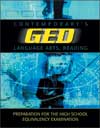The Language Arts, Reading Test measures a test-taker’s ability to understand and interpret reading passages and to apply interpretations of these passages to new contexts. Passages are drawn from both literary and nonfiction texts, but test-takers do not need to have prior knowledge of specific literary works in order to answer test items. Cognitive Levels and Content AreasThe Language Arts, Reading Test contains 40 multiple-choice items that are based on content from the following areas of literature: LITERARY TEXTS (5 passages—75%)- One poem
- One drama excerpt
- One fiction passage from before 1920
- One fiction passage from between 1920 and 1960
- One fiction passage from after 1960
NONFICTION PROSE (2 passages—25%)- Informational nonfiction (business documents, speeches, magazine and newspaper articles, research reports, and textbooks)
- Literary nonfiction (biographies, essays, diaries, memoirs, and letters)
- Visual communication (commentary on film, photography, television, sculpture, painting)
In addition, the test measures four categories of cognitive levels:
- Comprehension (20%)
- Application (15%)
- Analysis (30–35%)
- Synthesis (30–35%)
At least one synthesis item on the test is an extended synthesis question. This type of question introduces new material that is not presented in the original selection and asks test-takers to integrate this new material with the original in order to gain a more complete understanding of the reading passage. Context and FormatEach passage on the Language Arts, Reading Test is followed by four to eight items. Each passage also begins with a purpose question, which gives the test-taker a direction to follow as he or she begins reading. Below is an example of a typical reading selection with an extended synthesis question: WHAT DOES EDNA FEEL IS HER ROLE IN LIFE? Her marriage to Leoncé Pontellier was purely an accident, in this respect resembling many other marriages which masquerade as the decrees of Fate. It was in the midst of her secret great passion that she met him. He fell in love, as men are in the habit of doing, and pressed his suit with an earnestness and an ardor which left nothing to be desired. He pleased her; his absolute devotion flattered her. She fancied there was a sympathy of thought and taste between them, in which fancy she was mistaken. Add to this the violent opposition of her father and her sister Margaret to her marriage with a Catholic, and we need seek no further for the motives which led her to accept Mr. Pontellier for her husband. The acme of this bliss, which would have been a marriage with the tragedian, was not for her in this world. As the devoted wife of a man who worshipped her, she felt she would take her place with a certain dignity in the world of reality, closing the portals forever behind her upon the realm of romance and dreams. But it was not long before the tragedian had gone to join the cavalry officer and the engaged young man and a few others; Edna found herself face to face with the realities. She grew fond of her husband, realizing with some unaccountable satisfaction that no trace of passion or excessive and fictitious warmth colored her affection, thereby threatening its dissolution. —Excerpted from “The Awakening” by Kate Chopin, 1899Later in the story, Edna says, “I am no longer one of Mr. Pontellier’s possessions to dispose of or not.” What change in Edna does this later comment indicate?
(1) an awareness that she is her own person
(2) her refusal to be a mother to Leoncé’s children
(3) her following of the role assigned to her
(4) an acceptance of society’s standards for women
(5) her rejection of both her father and her husband
The correct answer to this item is option (1). In the first paragraph of the selection, the narrator reveals Edna’s independent streak, illustrated by her marriage to Mr. Pontellier over the “violent” objections of her father and sister. Now that she sees herself in a loveless marriage, she is ready to challenge society’s expectation that she is her husband’s property. |



 2002 McGraw-Hill Higher Education
2002 McGraw-Hill Higher Education

 2002 McGraw-Hill Higher Education
2002 McGraw-Hill Higher Education